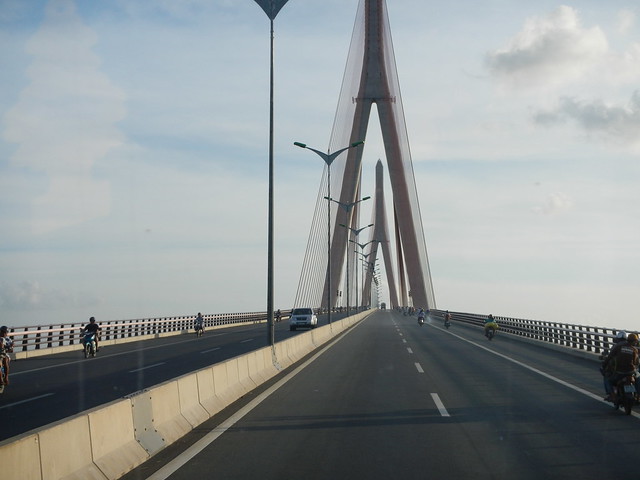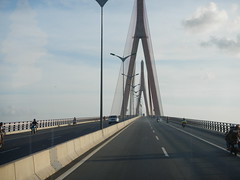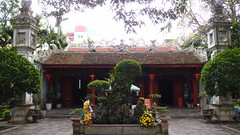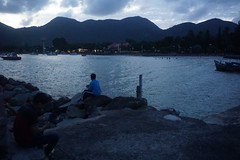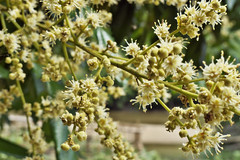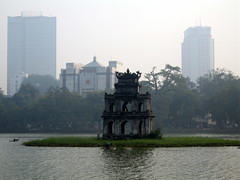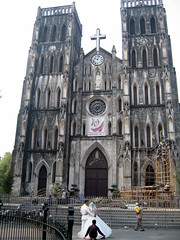 Vietnam
Vietnam
Vietnam or Viet Nam (commonly abbreviated VN; Vietnamese: Việt Nam, Vietnamese: [vîət nāːm]), officially the Socialist Republic of Vietnam (SRV), is a country in Southeast Asia. It is located at the eastern edge of mainland Southeast Asia, with an area of and population of 99 million, making it the world's fifteenth-most populous country. Vietnam borders China to the north, and Laos and Cambodia to the west. It shares maritime borders with Thailand through the Gulf of Thailand, and the Philippines, Indonesia, and Malaysia through the South China Sea. Its capital is Hanoi and its largest city is Ho Chi Minh City (commonly referred to by its former name, Saigon).
Vietnam was inhabited by the Paleolithic age, with states established in the first millennium BC on the Red River Delta in modern-day northern Vietnam. The Han dynasty annexed Northern and Central Vietnam under Chinese rule from 111 BC, until the first dynasty emerged in 939. Successive monarchical dynasties absorbed Chinese influences through Confucianism and Buddhism, and expanded southward to the Mekong Delta, conquering Champa. The Nguyễn—the last imperial dynasty—surrendered to France in 1883. Following the August Revolution, the nationalist coalition Viet Minh under the leadership of communist revolutionary Ho Chi Minh proclaimed independence of Vietnam in 1945.
Vietnam went through prolonged warfare in the 20th century. After World War II, France returned to reclaim colonial power in the First Indochina War, from which Vietnam emerged victorious in 1954. As a result of the treaties signed between the Viet Minh and France, Vietnam was also separated into two parts. The Vietnam War began shortly after, between the communist North, supported by the Soviet Union and China, and the anti-communist South, supported by the United States. Upon the North Vietnamese victory in 1975, Vietnam reunified as a unitary socialist state under the Communist Party of Vietnam (CPV) in 1976. An ineffective planned economy, a trade embargo by the West, and wars with Cambodia and China crippled the country further. In 1986, the CPV initiated economic and political reforms similar to the Chinese economic reform, transforming the country to a market-oriented economy. The reforms facilitated Vietnamese reintegration into the global economy and politics.
A developing country with a lower-middle-income economy, Vietnam is nonetheless one of the fastest-growing economies of the 21st century, with a GDP predicted to rival developed nations by 2050. Vietnam has high levels of corruption and censorship and a poor human rights record; the country ranks among the lowest in international measurements of civil liberties, freedom of the press, and freedom of religion and ethnic minorities. It is part of international and intergovernmental institutions including the ASEAN, the APEC, the CPTPP, the Non-Aligned Movement, the OIF, and the WTO. It has assumed a seat on the United Nations Security Council twice.
Etymology
The name (Vietnamese: [viə̀t naːm], chữ Hán), literally “Viet south”, means “Viet of the South” per Vietnamese word order or “South of the Viet” per Classical Chinese word order. A variation of the name, Nanyue (or Nam Việt), was first documented in the 2nd century BC. The term "" (Yue) in Early Middle Chinese was first written using the logograph "戉" for an axe (a homophone), in oracle bone and bronze inscriptions of the late Shang dynasty (BC), and later as "越". At that time it referred to a people or chieftain to the northwest of the Shang. In the early 8th century BC, a tribe on the middle Yangtze were called the Yangyue, a term later used for peoples further south. Between the 7th and 4th centuries BC Yue/Việt referred to the State of Yue in the lower Yangtze basin and its people. From the 3rd century BC the term was used for the non-Chinese populations of southern China and northern Vietnam, with particular ethnic groups called Minyue, Ouyue, Luoyue (Vietnamese: Lạc Việt), etc., collectively called the Baiyue (Bách Việt). The term Baiyue/Bách Việt first appeared in the book Lüshi Chunqiu compiled around 239 BC. By the 17th and 18th centuries AD, educated Vietnamese apparently referred to themselves as nguoi Viet (Viet people) or nguoi nam (southern people).
The form is first recorded in the 16th-century oracular poem Sấm Trạng Trình. The name has also been found on 12 steles carved in the 16th and 17th centuries, including one at Bao Lam Pagoda in Hải Phòng that dates to 1558. In 1802, Nguyễn Phúc Ánh (who later became Emperor Gia Long) established the Nguyễn dynasty. In the second year of his rule, he asked the Jiaqing Emperor of the Qing dynasty to confer on him the title 'King of Nam Việt / Nanyue' (in Chinese character) after seizing power in Annam. The Emperor refused because the name was related to Zhao Tuo's Nanyue, which included the regions of Guangxi and Guangdong in southern China. The Qing Emperor, therefore, decided to call the area "Việt Nam" instead, meaning “South of the Viet” per Classical Chinese word order but the Vietnamese understood it as “Viet of the South” per Vietnamese word order. Between 1804 and 1813, the name Vietnam was used officially by Emperor Gia Long. It was revived in the early 20th century in Phan Bội Châu's History of the Loss of Vietnam, and later by the Vietnamese Nationalist Party (VNQDĐ). The country was usually called Annam until 1945, when the imperial government in Huế adopted .
History
Prehistory and early history
Archaeological excavations have revealed the existence of humans in what is now Vietnam as early as the Paleolithic age. Stone artefacts excavated in Gia Lai province have been claimed to date to 0.78 Ma, based on associated find of tektites, however this claim has been challenged because tektites are often found in archaeological sites of various ages in Vietnam. Homo erectus fossils dating to around 500,000 BC have been found in caves in Lạng Sơn and Nghệ An provinces in northern Vietnam. The oldest Homo sapiens fossils from mainland Southeast Asia are of Middle Pleistocene provenance, and include isolated tooth fragments from Tham Om and Hang Hum. Teeth attributed to Homo sapiens from the Late Pleistocene have been found at Dong Can, and from the Early Holocene at Mai Da Dieu, Lang Gao and Lang Cuom. By about 1,000 BC, the development of wet-rice cultivation in the Ma River and Red River floodplains led to the flourishing of Đông Sơn culture, notable for its bronze casting used to make elaborate bronze Đông Sơn drums. At this point, the early Vietnamese kingdoms of Văn Lang and Âu Lạc appeared, and the culture's influence spread to other parts of Southeast Asia, including Maritime Southeast Asia, throughout the first millennium BC.
Dynastic Vietnam
According to Vietnamese legends, Hồng Bàng dynasty of the Hùng kings first established in 2879 BC is considered the first state in the history of Vietnam (then known as Xích Quỷ and later Văn Lang). In 257 BC, the last Hùng king was defeated by Thục Phán. He consolidated the Lạc Việt and Âu Việt tribes to form the Âu Lạc, proclaiming himself An Dương Vương. In 179 BC, a Chinese general named Zhao Tuo ("Triệu Đà") defeated An Dương Vương and consolidated Âu Lạc into Nanyue. However, Nanyue was itself incorporated into the empire of the Chinese Han dynasty in 111 BC after the Han–Nanyue War. For the next thousand years, what is now northern Vietnam remained mostly under Chinese rule. Early independence movements, such as those of the Trưng Sisters and Lady Triệu, were temporarily successful, though the region gained a longer period of independence as Vạn Xuân under the Anterior Lý dynasty between AD 544 and 602. By the early 10th century, Northern Vietnam had gained autonomy, but not sovereignty, under the Khúc family.
In AD 938, the Vietnamese lord Ngô Quyền defeated the forces of the Chinese Southern Han state at Bạch Đằng River and achieved full independence for Vietnam in 939 after a millennium of Chinese domination. By the 960s, the dynastic Đại Việt (Great Viet) kingdom was established, Vietnamese society enjoyed a golden era under the Lý and Trần dynasties. During the rule of the Trần Dynasty, Đại Việt repelled three Mongol invasions. Meanwhile, the Mahāyāna branch of Buddhism flourished and became the state religion. Following the 1406–7 Ming–Hồ War, which overthrew the Hồ dynasty, Vietnamese independence was interrupted briefly by the Chinese Ming dynasty, but was restored by Lê Lợi, the founder of the Lê dynasty. The Vietnamese polity reached their zenith in the Lê dynasty of the 15th century, especially during the reign of emperor Lê Thánh Tông (1460–1497). Between the 11th and 18th centuries, the Vietnamese polity expanded southward in a gradual process known as ("Southward expansion"), eventually conquering the kingdom of Champa and part of the Khmer Kingdom.
From the 16th century onward, civil strife and frequent political infighting engulfed much of Dai Viet. First, the Chinese-supported Mạc dynasty challenged the Lê dynasty's power. After the Mạc dynasty was defeated, the Lê dynasty was nominally reinstalled. Actual power, however, was divided between the northern Trịnh lords and the southern Nguyễn lords, who engaged in a civil war for more than four decades before a truce was called in the 1670s. Vietnam was divided into North (Trịnh) and South (Nguyễn) from 1600 to 1777. During this period, the Nguyễn expanded southern Vietnam into the Mekong Delta, annexing the Central Highlands and the Khmer lands in the Mekong Delta. The division of the country ended a century later when the Tây Sơn brothers helped Trịnh to end Nguyễn, they also established new dynasty and ended Trịnh. However, their rule did not last long, and they were defeated by the remnants of the Nguyễn lords, led by Nguyễn Ánh. Nguyễn Ánh unified Vietnam, and established the Nguyễn dynasty, ruling under the name Gia Long.
French Indochina
In the 1500s, the Portuguese explored th…
